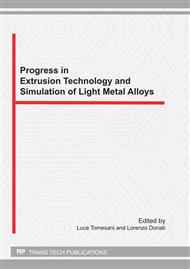p.137
p.145
p.151
p.159
p.173
p.181
p.189
p.197
p.205
Optimization of Aluminium Extrusion by Porthole Die Using a down Scaled Equipment
Abstract:
Porthole die extrusion has been always more used for the production of hollow profiles. The process is characterized by a complex die whose design is important for the product soundness. The quality of the welding line and, consequently, the quality of the extruded parts strictly depends on the extrusion optimization; for this reason, the influences that, each process parameter has on the pressure along the welding plane, have to be correctly understood. Unfortunately, the complexity of the die geometry generates great research difficulties if different parameters are analyzed; furthermore, even 3D numerical investigations present relevant drawbacks due to the high computational time and the results quality. In this work, a simplified and flexible porthole die is proposed; the equipment was designed and manufactured rectifying a quarter of a traditional porthole die. Moreover, the extruded part has flat shape with welding line in the middle; by doing that, its quality can be simply analyzed through standard tensile tests. Different geometrical variables were investigated, i.e., the bridge shape and width and the bearing length; their interactions on the process dynamics and on the product quality were also discussed. The Analysis of Variance (ANOVA) technique was used to evaluate the obtained results.
Info:
Periodical:
Pages:
173-180
Citation:
Online since:
September 2011
Authors:
Keywords:
Price:
Сopyright:
© 2012 Trans Tech Publications Ltd. All Rights Reserved
Share:
Citation:


